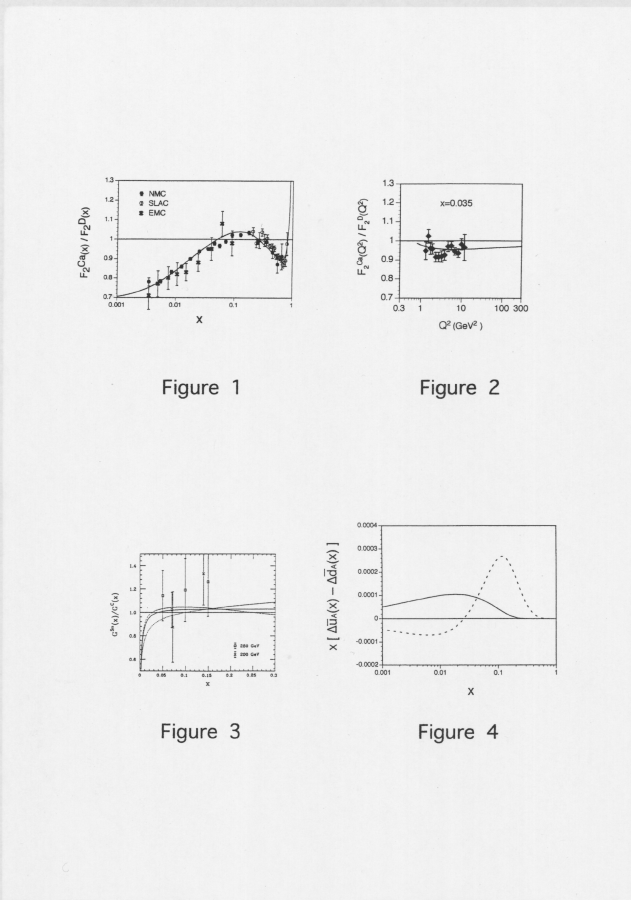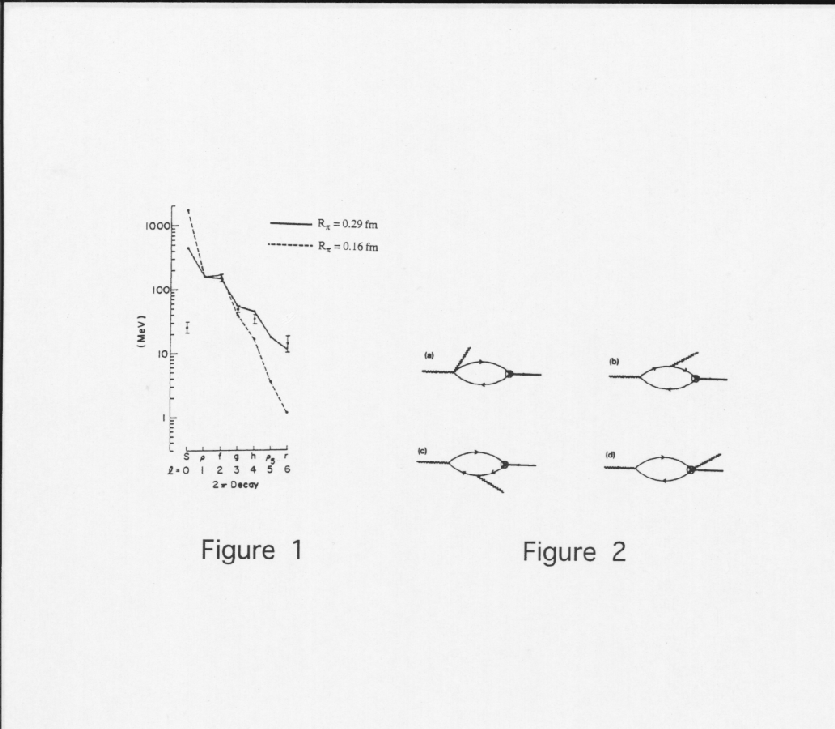 Figures 1-4.
Figures 1-4.
Index
Q$^2$ variation of the nuclear-structure-function ratio $F_2^A(x,Q^2)/F_2^D(x,Q^2)$ is investigated in a parton model with Q$^2$-rescaling and parton-recombination effects. Calculated results are compared with the NMC (New Muon Collaboration) and the Fermilab-E665 experimental data. We find that our theoretical results show small Q$^2$ variations and that they are consistent with the data within present experimental accuracy.
We investigate a numerical solution of the flavor-nonsinglet Altarelli-Parisi equation with next-to-leading-order $\alpha_s$ corrections by using Laguerre polynomials. Expanding a structure function (or a quark distribution) and a splitting function by the Laguerre polynomials, we reduce an integrodifferential equation to a summation of finite number of Laguerre coefficients. We provide a FORTRAN program for Q$^2$ evolution of nonsinglet structure functions (F$_1$, F$_2$, and F$_3$) and nonsinglet quark distributions. This is a very effective program with typical running time of a few seconds on SUN-IPX or on VAX-4000/500. Accurate evolution results are obtained by taking approximately twenty Laguerre polynomials.
Structures of f$_0$(975) and a$_0$(980) mesons could be investigated at $\phi$ factories. We discuss the possibility of discriminating among various structure models by measuring $\phi$ radiative decay widths. We also discuss whether $\phi\rightarrow K^0 \bar K^0\gamma$ is a significant background to CP violation studies at the $\phi$ factories.
SU(2)-flavor-symmetry breaking in antiquark distributions of the nucleon was suggested by the New Muon Collaboration (NMC) in deep inelastic muon scattering. As an independent test, Drell-Yan data for the tungsten target have been used for examining the asymmetry. We investigate whether there exists significant modification of the $\bar u -\bar d$ distribution in nuclei in a parton recombination model. It should be noted that a finite $\bar u-\bar d$ distribution is theoretically possible in nuclei even if the sea is $SU(2)_f$ symmetric in the nucleon. In neutron-excess nuclei such as the tungsten, there exist more $d$-valence quarks than $u$-valence quarks, so that more $\bar d$-quarks are lost than $\bar u$-quarks are due to parton recombinations in the small $x$ region. Our results suggest that the nuclear modification in the tungsten is a 2--10 \% effect on the $\bar u-\bar d$ distribution suggested by the NMC data. Nuclear effects on the flavor asymmetric distribution could be an interesting topic for future theoretical and experimental investigations.
We discuss two topics in this talk. One is a brief overview of nuclear parton distributions, and the other is SU(2)-flavor-symmetry breaking in {\it nuclear} antiquark distributions. First, we show that nuclear structure functions $F_2^A(x)$ could be explained in a $Q^2$ rescaling model with parton recombination effects. Then, nuclear gluon distributions are discussed in this parton model. We point out other interesting distributions for future investigations. Second, $\bar u-\bar d$ distributions in nuclei are discussed in order to shed light on nuclear modification of the $\bar u-\bar d$ distribution.
 Figures 1-4.
Figures 1-4.
It is interesting to study radiative decays of mesons in the mass region of 1--2 GeV at RCNP for investigating the details of hadron structure. Among the decays, $\phi$ radiative decays into f$_0$(975) and a$_0$(980) mesons are not measured yet, and studies of these decays could provide important clues on their substructures. Furthermore, it is likely that the studies open up the field of exotic mesons.
 Figures 1 and 2.
Figures 1 and 2.
We discuss numerical solution of Altarelli-Parisi equations in a Laguerre-polynomial method and in a brute-force method. In the Laguerre method, we get good accuracy by taking about twenty Laguerre polynomials in the flavor-nonsinglet case. Excellent evolution results are obtained in the singlet case by taking only ten Laguerre polynomials. The accuracy becomes slightly worse in the small and large $x$ regions, especially in the nonsinglet case. These problems could be implemented by using the brute-force method; however, running CPU time could be significantly longer than the one in the Laguerre method.
Nuclear modification of the structure function $F_3$ is investigated. Although it could be estimated in the medium and large $x$ regions from the nuclear structure function $F_2^A$, it is essentially unknown at small $x$. The nuclear structure function $F_3^A$ at small $x$ is investigated in two different theoretical models: a parton-recombination model with $Q^2$ rescaling and an aligned-jet model. We find that these models predict completely different behavior at small $x$: {\it antishadowing} in the first parton model and {\it shadowing} in the aligned-jet model. Therefore, studies of the ratio $F_3^A/F_3^D$ at small $x$ could be useful in discriminating among different models, which produce similar shadowing behavior in the structure function $F_2$. We also estimate currently acceptable nuclear modification of $F_3$ at small $x$ by using $F_2^A/F_2^D$ experimental data and baryon-number conservation.
Nuclear shadowing in the structure function $F_3$ is investigated as a possible test of shadowing models. The $F_3$ shadowing is studied in two different theoretical models: a parton-recombination model with $Q^2$ rescaling and an aligned-jet model. We find that predictions in these models differ completely in the small $x$ region. It suggests that the $F_3$ shadowing could be used for discriminating among different models, which produce similar shadowing behavior in the structure function $F_2$.
We investigate numerical solution of $Q^2$ evolution equations for structure functions in the nucleon and in nuclei. (Dokshitzer-Gribov-Lipatov-)Altarelli-Parisi and Mueller-Qiu evolution equations are solved in a brute-force method. Spin-independent flavor-nonsinglet and singlet equations with next-to-leading-order $\alpha_s$ corrections are studied. Dividing the variables $x$ and $Q^2$ into small steps, we simply solve the integrodifferential equations. Numerical results indicate that accuracy is better than 2\% in the region $10^{-4}\leq x\leq 0.8$ if more than two-hundred $Q^2$ steps and more than one-thousand $x$ steps are taken. The numerical solution is discussed in detail, and evolution results are compared with $Q^2$ dependent data in CDHSW, SLAC, BCDMS, EMC, NMC, Fermilab-E665, ZEUS, and H1 experiments. We provide a FORTRAN program for Q$^2$ evolution (and ``devolution'') of nonsinglet-quark, singlet-quark, $q_i+\bar q_i$, and gluon distributions (and corresponding structure functions) in the nucleon and in nuclei. This is a very useful program for studying spin-independent structure functions.
We propose to measure valence-quark shadowing by observing charged pion productions in electron-nucleus scattering at HERA. Studies of shadowing phenomena in the valence-quark distribution could be useful in discriminating among various models, which produce similar results in the $F_2$ shadowing.
$Q^2$ evolution of the structure functions $F_2$ in tin and carbon nuclei is investigated in order to understand recent NMC measurements. $F_2$ is evolved by using leading-order DGLAP, next-to-leading-order DGLAP, and parton-recombination equations. NMC experimental result $\partial [F_2^{Sn}/F_2^C]/ \partial [\ln Q^2]\ne 0$ could be essentially understood by the difference of parton distributions in the tin and carbon nuclei. However, we find an interesting indication that large higher-twist effects on the $Q^2$ evolution could be ruled out. Nuclear dependence of the $Q^2$ evolution could be interesting for further detailed studies.